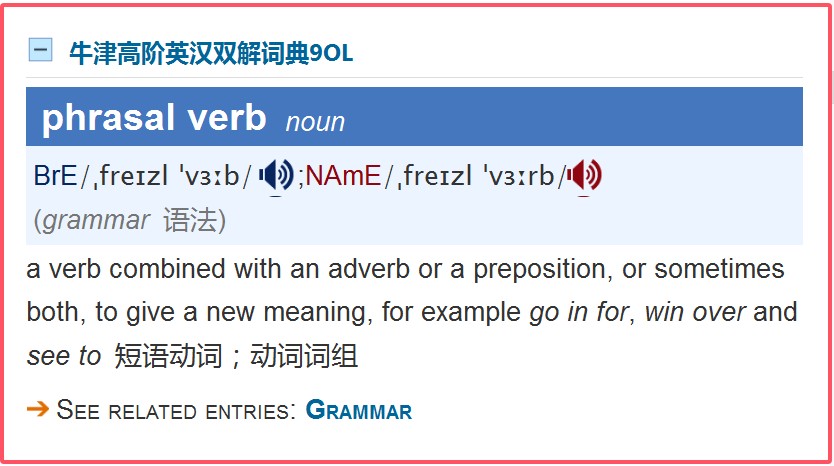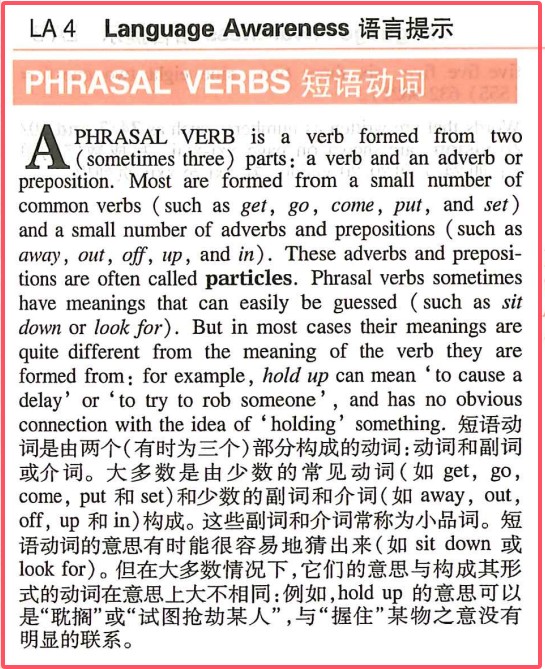4 短语动词的权威定义(涉及短语动词、介词动词、是否产生新义等)
请参考以下三个案例:
1. 不及物动词加介词是构成短语动词还是动状结构
https://www.cpsenglish.com/question/8552
2. 动词短语与短语动词的区别及用法
https://www.cpsenglish.com/question/26567
3. 短语动词与介词动词的定义与区别
https://www.cpsenglish.com/question/24548
前2个案例无一例外都提到了这么一个观点:
以动词+介词为例:若产生了新的词义为并且为固定搭配作为一个整体使用如look after照看照顾,为短语动词。
若仅仅是如 look at, 则不叫短语动词,但叫什么,都没有正面回答。
但是第3个案例里说:广义上来说,look after 和 look at都叫短语动词,狭义的说,look after是短语动词,look at叫:介词动词(我第一次听到这个名字)
这两种情况到底该怎么理解?
产生了新的词义的容易理解叫短语动词,那么还保持原本词义的叫什么名字?就叫介词动词吗?
最佳答案 2019-01-05 14:26
关于“短语动词”的定义,不同的辞书有不同的表述:
《牛津高阶学习词典英汉双解》第七版对phrasal verb(短语动词)的定义是这样的:

根据此定义可知:短语动词由动词跟介词或副词构成,或有时同时跟介词和副词构成,要产生新的词义(give a new meaning)。
《麦克米伦高阶英汉双解词典》在其“语言提示”中对phrasal verb的定义是这样表述的:

该定义告诉我们:短语动词的意思有时能很容易地猜出来(如sit down 或look for)。但在大多数情况下,它们的意思与构成其形式的动词在意思上大不相同:例如,hold up 的意思可以是“耽搁”或“试图抢劫某人”,与“握住”某物之意没有明显的联系——由此可知,该词典认为,即使表示字面意思,也可视为短语动词。
夸克等人的《英语语法大全》在第1593-1616页对短语动词也有相关描述,简要归纳如下:
对于“动词+介词/副词”类搭配,如果能单独根据动词和小品词的意义来预测组合后的意义,则为自由组合(free combinations);如果不能孤立地根据动词和小品词的意义来预测组合后的意义,则可细分为两类:一类是短语动词(phrasal verbs),即动词+副词类,如 find out 等,另一类是介词动词(prepositional verbs),即动词+介词类,如 care for 等。另外,夸克等人在《英语语法大全》中还补充一类所谓的“短语-介词动词”(phrasal-prepositional verbs),即由“短语动词+介词”构成,如put up with。
如果觉得我的回答对您有用,请随意打赏。你的支持将鼓励我继续创作!

其它 4 个回答
维基百科英文版:phrasal verb 短语动词
In English, a phrasal verb is a phrase such as turn down or ran into which combines two or three words from different grammatical categories: a verb and a particle and/or a preposition together form a single semantic unit. This semantic unit cannot be understood based upon the meanings of the individual parts, but must be taken as a whole. In other words, the meaning is non-compositional and thus unpredictable.[1] Phrasal verbs that include a preposition are known as prepositional verbs and phrasal verbs that include a particle are also known as particle verbs. Additional alternative terms for phrasal verb are compound verb, verb-adverb combination, verb-particle construction, two-part word/verb, and three-part word/verb (depending on the number of particles), and multi-word verb.[2]
verb phrase 动词短语
In linguistics, a verb phrase (VP) is a syntactic unit composed of at least one verb and its dependents—objects, complements and other modifiers—but not always including the subject. Thus in the sentence A fat man put the money quickly in the box, the words put the money quickly in the box are a verb phrase; it consists of the verb put and its dependents, but not the subject a fat man. A verb phrase is similar to what is considered a predicate in more traditional grammars.
如果觉得我的回答对您有用,请随意打赏。你的支持将鼓励我继续创作!

A:短语动词:有动词+小品词(介词/副词)构成的动词词组。
(1)动词+介词:
look at
look after
look for
laugh at
come across
(2)动词+副词:
take off
put on
look up
have on
take away
put aside
put away
B:动词短语:由动词+名词+介词 构成的动词词组。
take a look at
catch hold of
catch sight of
take the place of
take care of
如果觉得我的回答对您有用,请随意打赏。你的支持将鼓励我继续创作!

- 6 关注
- 15 收藏,9049 浏览
- 山东love能泰山 提出于 2019-01-03 19:48
相似问题
- 短语动词的介词后可以不跟宾语(省略宾语) 1 回答
- set up什么意思 1 回答
- 短语动词的理解(字面意义短语动词与成语性短语动词) 1 回答
- 如何理解题干里的working with 1 回答
- 不及物动词加介词就相当于及物动词吗 1 回答
- 短语动词的翻译 1 回答
-
 《高考英语备考1号·速效编》
《高考英语备考1号·速效编》
-
 《高考英语备考1号·写作编》
《高考英语备考1号·写作编》
-
 《高中英语晨读晚记》
《高中英语晨读晚记》
-
 《高中英语错题笔记》
《高中英语错题笔记》
-
 《零起点考大学英语》
《零起点考大学英语》
-
